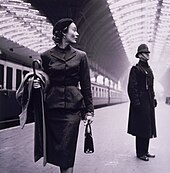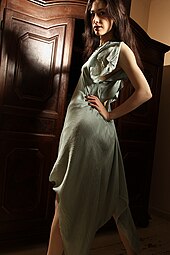Fashion photography



The fashion photography is a branch of photography , in the clothing fashions mostly for the purpose of advertising is displayed and sale. However, it is true of haute couture photography that the photographers of the genre read themselves like a who's who of 20th and 21st century photography. In recent years, fashion photography has succeeded in being included in the canon of the arts, as it is exhibited in numerous museums and galleries as an independent genre of photography.
Classification in the genres of photography
Fashion photography has always struggled with the image of commissioned creativity, the task of which is purely commercial. Fashion photography is the fuck word in art, commented Richard Avedon in 1970, it was dirty, frowned upon, not really art. Critics, curators and museum directors also saw her at times as frivolous, decadent, self-indulgent to vain, superficial, fleeting, and commercial. The flaw of being able to be little more than a photographic poster that is primarily intended to encourage people to buy, did not make it easy for her to establish herself as an art form in the academic art world. In any case, the genre never claimed authenticity, it was and is often perfectly staged advertising photography of the beautiful.
"A fashion photo is not a photo of a dress - it is a photo of a woman."
history
19th century
The forerunners of the first fashion photographs date back to 1856. Adolphe Braun published a book with 288 photographs of Virginia Oldoini , Comtesse de Castiglione, a Tuscan noblewoman at Napoleon III's court . The Comtesse showed off her wardrobe in these pictures and thus became the first photo model in history.
Clementina Hawarden's pictures can also be seen as early evidence of fashion photography. In her elegant house in London she set up a photographic studio in which the characteristic portraits of her daughters were created. The arrangements and compositions of their models, the Victorian clothing and furnishings were way ahead of their time.
In 1892 the first reproduced fashion photography appeared in the French publication La Mode Pratique .
20th century
At the beginning of the 20th century, fashion photography appeared in magazines such as Harper's Bazaar and Les Modes . At the same time, photo studios for fashion photography established themselves in European capitals such as the studios “Reutlinger”, “Talbot” (Paris), “Willinger” or “Binder” (Berlin). In 1909 Condé Nast took over Vogue magazine and Baron Adolphe de Meyer developed new staging of the images in which the independence of fashion photography is rooted. Meyer depicted the models in natural surroundings and natural poses. Vogue fashion magazine and its strongest competitor, Harper's Bazaar, led fashion photography to a respected art form in the 1920s and 1930s. Important protagonists at this time were Edward Steichen , George Hoyningen-Huene , Horst P. Horst , Dora Maars and Cecil Beaton . Also surrealist photo artists such as Man Ray and Lee Miller worked for this genre. Yva successfully established her studio in Berlin, where Helmut Newton was trained.
The Second World War marked an important turning point for fashion photography. The focus of the work of fashion photographers shifted from Europe to the USA. There the two big magazines Vogue and Harper's Bazaar competed for the market. Her in-house photographers, first and foremost Louise Dahl-Wolfe , but also Irving Penn , Martin Munkácsi and Richard Avedon , were to have a decisive influence on the “look” of fashion photography for the next few decades. Fashion photography broke away from its rigid positions and developed a freer visual language. The photographer Martin Munkácsi was the first to take pictures of models on the beach in sporty poses in 1936, Louise Dahl-Wolfe mainly worked with natural light for her fashion shoots and influenced her younger colleagues with her style.
Under the artistic direction of Alexey Brodovitch , Harper's Bazaar has just implemented this new image concept in their magazine. Richard Avedon was the main contributor in the 1950s. In the German-speaking countries, for example, Regina Relang , Walter E. Lautenbacher , FC Gundlach and Willy Maywald developed into great names in fashion photography in the 1950s and 1960s .
In the 1960s, photographers David Bailey or Bob Richardson , Terry Richardson's father , revolutionized fashion photography. New models such as Twiggy or Jean Shrimpton represented a generation change and a rejuvenated, more dynamic style.
In the 1970s, photographers like Guy Bourdin and Helmut Newton , who worked for Vogue , pushed the boundaries of the genre. Topics such as fetishism, pornography and voyeurism found their way into classic fashion photography.
The 1980s, however, saw a new generation of photographers. Peter Lindbergh , Herb Ritts and Bruce Weber staged beautiful aesthetic worlds; the influence of the big marketing departments on the fashion magazines was visible, black and white photography experienced a comeback. Supermodels such as Linda Evangelista , Christy Turlington , Naomi Campbell , Tatjana Patitz or Claudia Schiffer exemplified the era of perfect staging. However, there were also rebels: with the Benetton campaign in the 1980s, Oliviero Toscani broke through traditional viewing habits and even scandalized, but also with a conceptually consistent visual language of high emotional tonality .
In the 1990s, some photographers turned to a "new realism" and turned away from the smooth and hyper-aesthetic worlds. Photographers influenced by subcultures such as Juergen Teller , Wolfgang Tillmans or Nick Knight shaped the so-called “heroine looks”, while models like Kate Moss were icons of the decade. At the same time, fashion photographers like David LaChapelle or Steven Meisel developed their own glamorous style.
21st century
Terry Richardson provoked the scene from 2000 with revealing photos from the Sisley campaign ; his photography, based on the aesthetics of porn , broke taboos. Richardson was therefore associated with the style of porn chic by the media . The Guardian newspaper described Richardson's controversial style of fashion photography as " soft porn ". However, breaking taboos also earned him a certain cult character.
The 21st century is also shaped by the digital transformation as a mega-trend in the fashion industry. The magic of the exclusivity of a fashion presentation was broken by bloggers and influencers who sit in the front row at fashion shows today. Photos of the coming season will go online during the show, will be shared and liked. Art directors, industry insiders and classic glossy media are losing their usual gatekeeper functions. Bloggers and influencers not only post the latest styles, but above all themselves on platforms like Instagram . Street stars are shown instead of divas, real people instead of models. Fashion photography is becoming mass-compatible and new genres are emerging on this basis, such as street fashion photography. It seems as if classic fashion photography has arrived in museums, but photographic forms of expression and imagery are fundamentally changing.
Auction record
Richard Avedon holds the previous auction record for a fashion photo: “ Dovima with elephants ” (1955) - a commissioned work for “Harper's Bazaar” was auctioned in 2010 for 841,000 euros.
Web links
Exhibitions
- 1990: Fashion Photography - From 1900 to today , Kunstforum Länderbank, today Bank Austria Kunstforum .
- 2004: Fashioning Fiction in Photography since 1990 , Museum of Modern Art (MoMA) , New York City.
- 2012: Timelessly beautiful - 100 years of fashion photography from Man Ray to Mario Testino at C / O Berlin .
- 2012: Herb Ritts , J. Paul Getty Museum , Los Angeles.
- 2016: Robert Mapplethorpe , J. Paul Getty Museum , Los Angeles.
- 2018: Icons of Style, J. Paul Getty Museum , Los Angeles .
literature
- Walter E. Lautenbacher, Staged Fashion Photography 1953 - 1983 and how it came about. A chronology. , 1994, ISBN 3-89322-677-X , awarded the Kodak Photo Book Prize
- Walter E. Lautenbacher, Mode, Models and their Photographer , 2000, ISBN 3-933989-06-X (25 short stories about fashion photo expeditions in the years 1958–1975)
- Nancy Hall-Duncan, The History of Fashion Photography , New York 1979, ISBN 0-933516-00-2
- Sven Hanefeld, History of Fashion & Beauty Photography - The 19th Century , 2016 ISBN 978-3-7412-2201-6
- Burcu Dogramaci, Sebastian Lux, Ulrich Rüter (eds.), Interfaces. Mode and Photography in Dialog , Hamburg 2010, ISBN 978-3-936406-25-2
- Marion Wittfeld, "Educating taste and style". Fashion photography under National Socialism using the example of the magazine “Mode und Heim” (1931–1944) . In: Zeithistorische Forschungen 12 (2015), pp. 356–369.
Individual evidence
- ^ A b Sarah Pines: Fashion Photography in the Times of Instagram . In: THE WORLD . July 22, 2018 ( welt.de [accessed January 22, 2020]).
- ↑ Katja Iken, DER SPIEGEL: Benetton shock advertising in the nineties: "I don't give a shit about sweaters!" - DER SPIEGEL - history. Accessed January 21, 2020 .
- ↑ Marc Zollinger: The provocative Benetton photographer is back - and despite his 76 years of age, he is not mild with age NZZ . In: Neue Zürcher Zeitung . ( nzz.ch [accessed on January 21, 2020]).
- ^ Helene Kalinowsky (October 23, 2013). Petition against Terry Richardson: Star photographer allegedly harassed models. MSN (accessed January 24, 2014)
- ^ Caroline Davies (March 19, 2010). Guardian (accessed April 28, 2010)
- ↑ a b The changing fashion industry. Retrieved January 22, 2020 .
